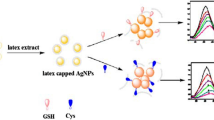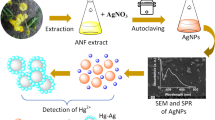Abstract
In the presented manuscript, spherical silver nanoparticles (AgNPs) which were prepared via green chemical method in a single step take only a few minutes to be ready as a Hg2+ ions detector based on the plasmon band changes. The AgNPs were obtained with the aqueous extract of Mimusops coriacea leaves. The components of the extract as tannins and polyphenolic compounds were responsible for the reduction in metal ions and the particles encapsulation. The AgNPs were characterized by UV–Vis spectroscopy, fluorescence, Fourier transform infrared, dynamic light scattering analysis and transmission electron microscopy. The AgNps presented an average diameter of 15 nm and a zeta potential value of ~ − 28 mV. They were monodispersed and stable for up to 180 days. AgNPs are used as a Hg2+ sensor with high sensitivity and selectivity. The fast, simple and low-cost method is based on changes in the AgNP surface plasmon resonance band (λ ≈ 410 nm) with LOD 6.5 ng/mL (32.5 nM), without functionalization of the AgNPs. The low LOD demonstrates its potential for Hg2+ quantification in environmental samples such as fish, soil, and effluent discharge.
Graphic abstract









Similar content being viewed by others
Data availability
Contact the authors for information on data availability.
References
UNEP (2019) Minamata Convention on Mercury. http://www.mercuryconvention.org/Convention/Text/tabid/3426/language/en-US/Default.aspx. Accessed 10 August 2020
BRASIL (2013) Diagnóstico Preliminar sobre o Mercúrio no Brasil. Ministério do Meio Ambiente
Farias L.A (2006) Avaliação do Conteúdo de Mercúrio, Metilmercúrio e Outros Elementos de Interesse em Peixes e em Amostras de Cabelos e Dietas de Pré-Escolares da Região Amazônica. Thesis, Universidade Federal de São Paulo
WAD J,(2010) Especiação, Quantificação, Distribuição e Transporte de Mercúrio em Solos Contaminados do Município de Descoberto, Belo Horizonte. Dissertation, Universidade Federal de Minas Gerais
F. Chai, C. Wang, T. Wang, Z. Ma, Z. Su, L-cysteine functionalized gold nanoparticles for the colorimetric detection of Hg2+ induced by ultraviolet light. Nanotechnology 21(2), 025501 (2009). https://doi.org/10.1088/0957-4484/21/2/025501
J. Duan, H. Yin, R. Wei, W. Wang, Facile colorimetric detection of Hg2+ based on anti-aggregation of silver nanoparticles. Biosens. Bioelectron. 57, 139–142 (2014). https://doi.org/10.1016/j.bios.2014.02.007
L. Li, B. Li, Y. Qi, Y. Jin, Label-free aptamer-based colorimetric detection of mercury ions in aqueous media using unmodified gold nanoparticles as colorimetric probe. Anal. Bioanal. Chem. 393(8), 2051–2057 (2009). https://doi.org/10.1007/s00216-009-2640-0
G. Sener, L. Uzun, A. Denizli, Lysine-promoted colorimetric response of gold nanoparticles: a simple assay for ultrasensitive mercury(II) detection. Anal. Chem. 86(1), 514–520 (2014). https://doi.org/10.1021/ac403447a
P. Sharma et al., Thiol terminated chitosan capped silver nanoparticles for sensitive and selective detection of mercury (II) ions in water. Sens. Actuators B: Chem. 268, 310–318 (2018). https://doi.org/10.1016/j.snb.2018.04.121
Albernaz VL (2014) Síntese verde de nanopartículas de prata com extrato aquoso de folhas de Brosimum gaudichaudii, caracterização fisicoquímica, morfológica e suas aplicações no desenvolvimento de um nanobiossensor eletroquímico. Dissertation, Universidade de Brasilia
S. Iravani, Green synthesis of metal nanoparticles using plants. Green Chem. 13(20), 2638 (2011). https://doi.org/10.1039/C1GC15386B
A. Mishra et al., Microbial synthesis of gold nanoparticles using the fungus Penicillium brevicompactum and their cytotoxic effects against mouse mayo blast cancer C2C12 cells. Appl. Microbiol. Biotechnol. 92(3), 617–630 (2011). https://doi.org/10.1007/s00253-011-3556-0
V.K. Sharma, R.A. Yngard, Y. Lin, Silver nanoparticles: green synthesis and their antimicrobial activities. Adv. Coll. Interface. Sci. 145, 83–96 (2009). https://doi.org/10.1016/j.cis.2008.09.002
H. Itoh, K. Naka, Y. Chujo, Synthesis of gold nanoparticles modified with ionic liquid based on the imidazolium cation. J. Am. Chem. Soc. 126(10), 3026–3027 (2004). https://doi.org/10.1021/ja039895g
P. Singh, K. Kumari, A. Katyal, R. Kalra, R. Chandra, Synthesis and characterization of silver and gold nanoparticles in ionic liquid. Spectrochim. Acta Part A Mol. Biomol. Spectrosc. 73(1), 218–220 (2009). https://doi.org/10.1016/j.saa.2009.02.007
R. Lu, D. Yang, D. Cui, Z. Wang, L. Guo, Egg white-mediated green synthesis of silver nanoparticles with excellent biocompatibility and enhanced radiation effects on cancer cells. Int. J. Nanomed. 7, 2101–2107 (2012). https://doi.org/10.2147/IJN.S29762
R.A. De Matos, L.C. Courrol, Saliva and light as templates for the green synthesis of silver nanoparticles. Coll. Surf.A Physicochem. Eng. Asp. 441, 539–543 (2014). https://doi.org/10.1016/j.colsurfa.2013.10.009
J.L. Gardea-Torresdey, E. Gomez, J.R. Peralta-Videa, J.G. Parsons, H. Troiani, M. Jose-Yacaman, Alfalfa sprouts: a natural source for the synthesis of silver nanoparticles. Langmuir 19(4), 1357–1361 (2003). https://doi.org/10.1021/la020835i
A.K. Mittal, Y. Chisti, U.C. Banerjee, Synthesis of metallic nanoparticles using plant extracts. Biotechnol. Adv. 31, 346–356 (2013). https://doi.org/10.1016/j.biotechadv.2013.01.003
P. Rauwel, S. Kuunal, S. Ferdov, E. Rauwel, A review on the green synthesis of silver nanoparticles and their morphologies studied via TEM. Adv. Mater. Sci. Eng. (2015). https://doi.org/10.1155/2015/682749
J. Park, S.-H. Cha, S. Cho, Y. Park, Green synthesis of gold and silver nanoparticles using gallic acid: catalytic activity and conversion yield toward the 4-nitrophenol reduction reaction. J. Nanopart. Res. 18(6), 166 (2016). https://doi.org/10.1007/s11051-016-3466-2
C.R.B. Lopes, L.C. Courrol, Green synthesis of silver nanoparticles with extract of Mimusops coriacea and light. J. Lumin. 199, 183–187 (2018). https://doi.org/10.1016/j.jlumin.2018.03.030
D. Wang, Q. Gai, R. Huang, X. Zheng, Label-free electrochemiluminescence assay for aqueous Hg2+ through oligonucleotide mediated assembly of gold nanoparticles. Biosens. Bioelectron. 98, 134–139 (2017). https://doi.org/10.1016/j.bios.2017.06.054
Y. Liu et al., Turn-on fluoresence sensor for Hg2+ in food based on fret between aptamers-functionalized upconversion nanoparticles and gold nanoparticles. J. Agric. Food Chem. 66(24), 6188–6195 (2018). https://doi.org/10.1021/acs.jafc.8b00546
S. Jia, C. Bian, J. Sun, J. Tong, X. Shanhong, A wavelength-modulated localized surface plasmon resonance (LSPR) optical fiber sensor for sensitive detection of mercury(II) ion by gold nanoparticles-DNA conjugates. Biosens Bioelectron 114, 15–21 (2018). https://doi.org/10.1016/j.bios.2018.05.004
A.N. Vijayan, L. Zhiming, Z. Haohan, P. Zhang, Nicking enzyme-assisted signal-amplifiable Hg2+ detection using upconversion nanoparticles. Anal. Chim. Acta 1072, 75–80 (2019). https://doi.org/10.1016/j.aca.2019.05.001
C.O. Amorim et al., Ultra sensitive quantification of Hg2+ sorption by functionalized nanoparticles using radioactive tracker spectroscopy. Microchem. J. 138, 418–423 (2018). https://doi.org/10.1016/j.microc.2018.01.039
P. Preposito et al., Bifunctionalized silver nanoparticles as hg2+ plasmonic sensor in water: synthesis, characterizations, and ecosafety. Nanomaterials 9(10), 1353 (2019). https://doi.org/10.3390/nano9101353
S. Ghosh, S. Maji, A. Mondal, Study of selective sensing of Hg2+ ions by green synthesized silver nanoparticles suppressing the effect of Fe3+ ions. Colloids Surf., A 555, 324–331 (2018). https://doi.org/10.1016/j.colsurfa.2018.07.012
L. Currie, Detection and quantification limits: origins and historical overview. Anal. Chim. Acta 391, 127–134 (1999). https://doi.org/10.1016/S0003-2670(99)00105-1
E. Bulut, Rapid, facile synthesis of silver nanostructure using hydrolyzable tannin. Ind. Eng. Chem. Res. (2009). https://doi.org/10.1021/ie801779f
K.J. Rao, S. Paria, Green synthesis of silver nanoparticles from aqueous Aegle marmelos leaf extract. Mater. Res. Bull. 48(2), 628–634 (2013). https://doi.org/10.1016/j.materresbull.2012.11.035
Z. Mashwani, T. Khan, M.A. Khan, A. Nadhman, Synthesis in plants and plant extracts of silver nanoparticles with potent antimicrobial properties: current status and future prospects. Appl. Microbiol. Biotechnol. 99, 9923–9934 (2015). https://doi.org/10.1007/s00253-015-6987-1
P. Prakash, P. Gnanaprakasam, R. Emmanuel, S. Arokiyaraj, M. Saravanan, Green synthesis of silver nanoparticles from leaf extract of Mimusops elengi, Linn. for enhanced antibacterial activity against multi drug resistant clinical isolates. Coll. Surf. B: Biointerf. 108, 255–259 (2013). https://doi.org/10.1016/j.colsurfb.2013.03.017
S. Satish, M.P. Raghavendra, D.C. Mohana, K.A. Raveesha, Antifungal activity of a known medicinal plant Mimusops elengi L against grain moulds. J Agric Technol 4(1), 151–165 (2008)
S. Rajeshkumar, L.V. Bharath, Mechanism of plant-mediated synthesis of silver nanoparticles – a review on biomolecules involved, characterization and antibacterial activity. Chem. Biol. Interact. 273, 219–227 (2017). https://doi.org/10.1016/j.cbi.2017.06.019
R. Veerasamy et al., Biosynthesis of silver nanoparticles using mangosteen leaf extract and evaluation of their antimicrobial activities. J. Saudi Chem. Soc. 15(2), 113–120 (2011). https://doi.org/10.1016/j.jscs.2010.06.004
P. Khoroshyy, D. Bína, Z. Gardian, R. Litvín, J. Alster, J. Pšenčík, Quenching of chlorophyll triplet states by carotenoids in algal light-harvesting complexes related to fucoxanthin-chlorophyll protein. Photosynth. Res. 135(1–3), 213–225 (2018). https://doi.org/10.1007/s11120-017-0416-5
Acknowledgements
The authors would like to thank CAPES for financial support and Multiuser Facilities Central at UFABC for the experimental support and São Paulo Research Foundation (FAPESP) for Grant #2017/23686-6.
Funding
This research was funded by Coordenação de Aperfeiçoamento de Pessoal de Nível Superior – Brasil (CAPES) and Grant #2017/23686–6 of São Paulo Research Foundation (FAPESP).
Author information
Authors and Affiliations
Corresponding author
Ethics declarations
Conflict of interest
There are no conflicts to declare.
Additional information
Publisher's Note
Springer Nature remains neutral with regard to jurisdictional claims in published maps and institutional affiliations.
Supplementary information
Below is the link to the electronic supplementary material.
Rights and permissions
About this article
Cite this article
Lopes, C.R.B., Junior, D.S., Silva, F.R.d. et al. High-sensitivity Hg2+ sensor based on the optical properties of silver nanoparticles synthesized with aqueous leaf extract of Mimusops coriacea. Appl. Phys. A 127, 244 (2021). https://doi.org/10.1007/s00339-021-04391-2
Received:
Accepted:
Published:
DOI: https://doi.org/10.1007/s00339-021-04391-2




